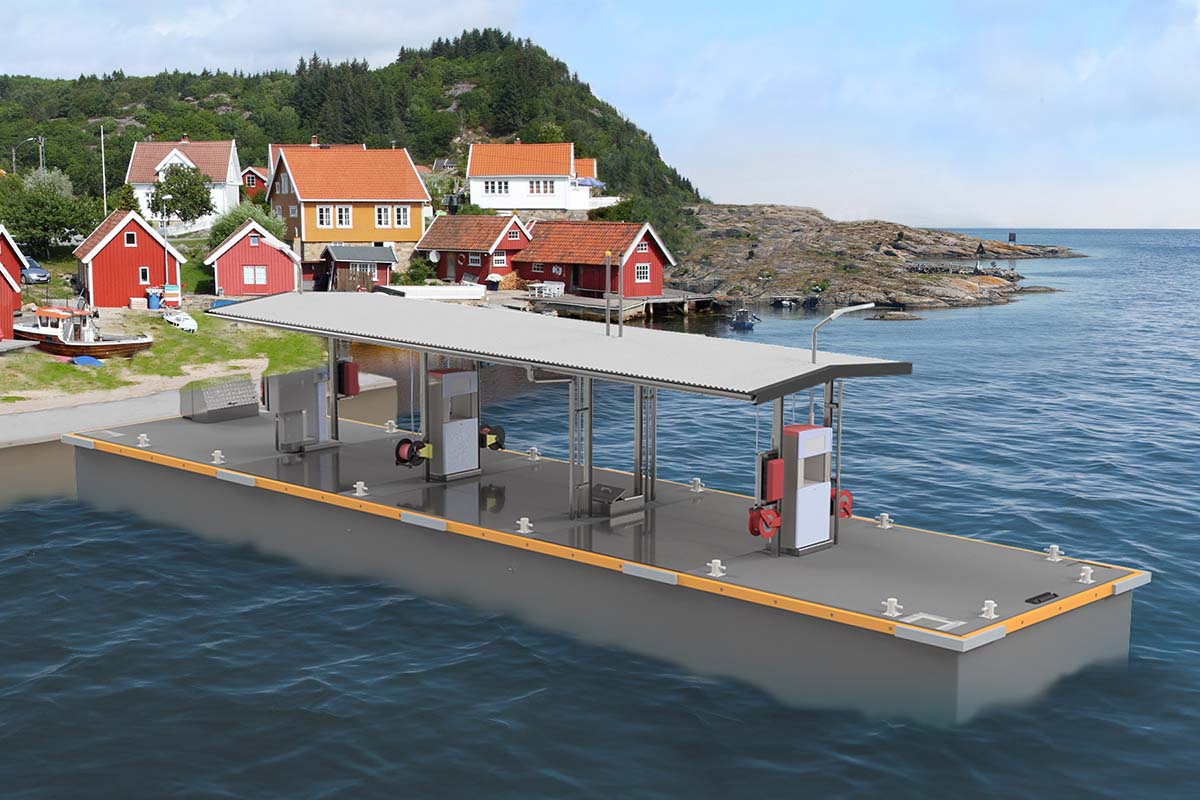
SF Marina Turns Trash and Fuel Handling Green
Published on April 28, 2025Necessity may be the “mother of invention,” but on the waterfront, regulations are more likely to prompt innovation. This has been true for SF Marina’s latest product, the Refuel Dock, which stemmed from stricter Scandinavian and German regulations for fuel storage. This latest release joins another unique design, with both quickly catching on in Europe and headed for the U.S. market.
SF Marina is known for its concrete floating docks, which are custom assembled to client specifications in its Wallhamn, Sweden, headquarters as well as at smaller production facilities in Egypt, Greece, Spain, Turkey, Saudi Arabia, the UAE, New Zealand, the United States, Thailand, South Korea and India. The company cast its first concrete dock in 1918 and has since installed more than 150,000 docks across 60 countries. A century of experience has helped guide the company toward imagining and creating unique designs.
The basis for all the company’s docks is a closed-cell foam core and steel reinforcement surrounded by high-quality concrete layers. The docks meet a variety of applications from small facility needs to commercial ports.
Capturing the latest in environmental practices, the company’s new docks are forerunners to what marinas can expect in the future.
Refuel Dock
SF Marina’s latest innovation is the Refuel Dock, a floating concrete dock that houses fuel tanks. The project was a collaboration between SF Marina and Malte Group, which is a Scandinavian company specializing in fuel and vessel wash systems. According to Anders Lindberg, SF Marina’s factory manager, SF Marina has been making floating fuel tanks for several years, but under new regulations, the company needed to make the tanks leak-proof and inspectable.
SF Marina turned to Malte to assist in finding a solution. Daniel Salomonsson of Malte said, “We painted the ‘hollow’ in the pontoon with Jotun Tankguard, which means if the tank were to leak, fuel will not leak out. The walls and the floor of the stainless-steel tank are fully protected.”
Previous iterations of pontoon-based fuel tanks had a small opening where fuel was delivered, making it nearly impossible to conduct an inspection of the tank. The new design uses a stainless-steel lid, allowing the tank to open like a shoebox so cameras can be sent into the tanks for a more complete inspection.
“Through this solution, we eliminate the risk of fuel leaking into the water, and if there is a leak, we have a monitoring alarm that indicates if there is a leak in the secondary protection,” Salomonsson said.
The floating fuel tanks also solve the problem of limited land space for storage tanks and fuel lines. The tanks can be filled directly from the land or water. The internal tanks can be separated from fewer larger tanks to a series of small tanks to accommodate a variety of fuel types. The company works with different fuel brands depending on the suppliers available near the installation.
Salomonsson said that the docks offer “safety zones” around the filling box, dispensers, vent pipe and tanks where a power pedestal or pumpout could be installed without further risk of exposing fuel to electric currents.
The limiting factor to using the docks is that due to their size, they require water transport, making delivery a challenge to some marina locations. However, the stability offered with a floating concrete dock makes them a wise choice for fueling operations. “It’s like walking on the ground, not a dock,” Lindberg said. “The footing doesn’t change much with waves and wind.”
Technology Behind EcoDock
Trash removal and recycling shift to the water through SF Marina’s EcoDock. The concrete floating dock houses 5-cubic-meter Molok containers, fitted with removable bags. The waterproof receptacles sink down below the water’s surface to offer added space for collection, while the cool water helps reduce odors. The waste compacts through gravity, over time increasing the container capacity by up to 20% and reducing the number of times the trash needs to be collected.
Smart technology built into the system monitors the capacity, sending alerts when it’s time for the trash to be removed. Lindberg said removal of the bags requires a simple crane, either attached to a barge or boat for water pickup or from a land-based operation. “Many marinas already have cranes for boat hauling, so that makes trash removal simple,” he said. Convenience is a priority in encouraging boaters to dispose of trash and recyclables properly, and having bins available as patrons step off their boats is a benefit.
The docks can be customized by length, width and even angles to fit in most spaces. Designed for ease of installation, the docks are secured with heavy chains and embedded anchors or can be attached to piles. The options make them usable in diverse environments with varying bottom lands.
The final green element to the EcoDock is that they can be recycled at the end of their lifecycle.
Both docks can be easily unhooked and moved to allow access from different areas of the marina basin as needed. They also come in customizable sizes to meet space requirements and transportation needs, and they are offered with added amenities such as bollards, lighting and rub rails. “All of our products are custom-built and not kept in stock,” Lindberg said. “We can build wider or longer, add more tanks or dispensers, whatever the customer needs.”
SF Marina’s dock innovations provide environmentally sound solutions to help ensure a cleaner future. On a more practical day-to-day basis, moving items like fuel storage and recycling centers to the water frees upland space for more profitable amenities.
While installations of the Refuel Dock and EcoDock have only been in Sweden, Denmark and Norway to date, the company is working on the process to bring its new products to the U.S. market soon.
| Categories | |
| Tags |





